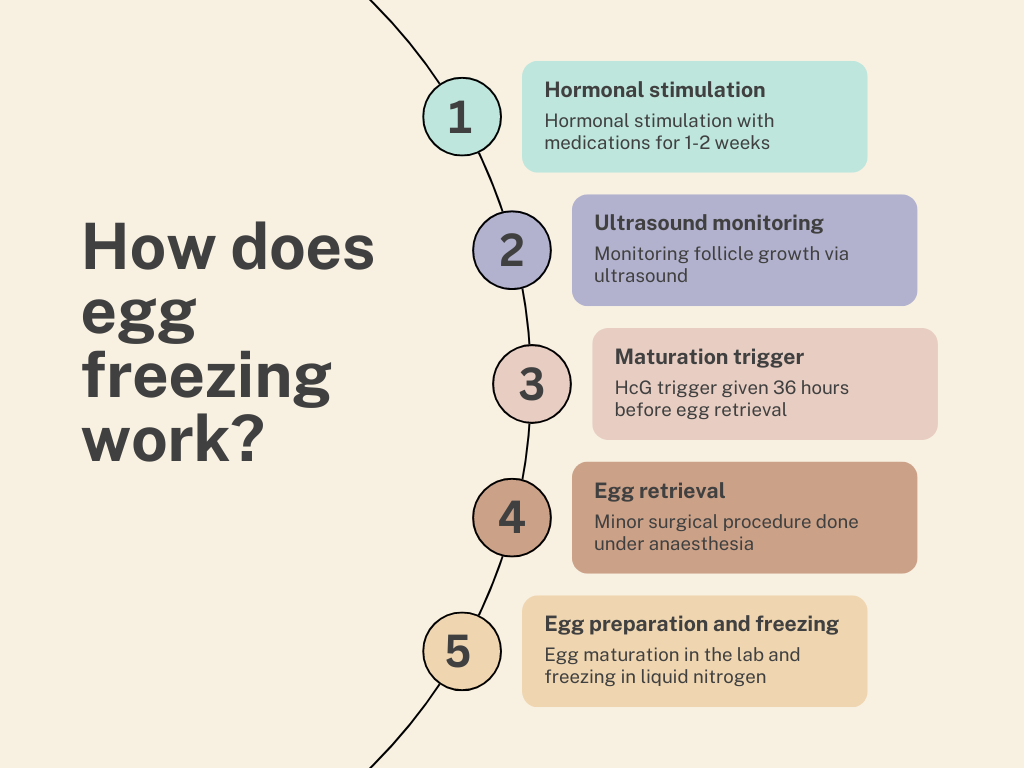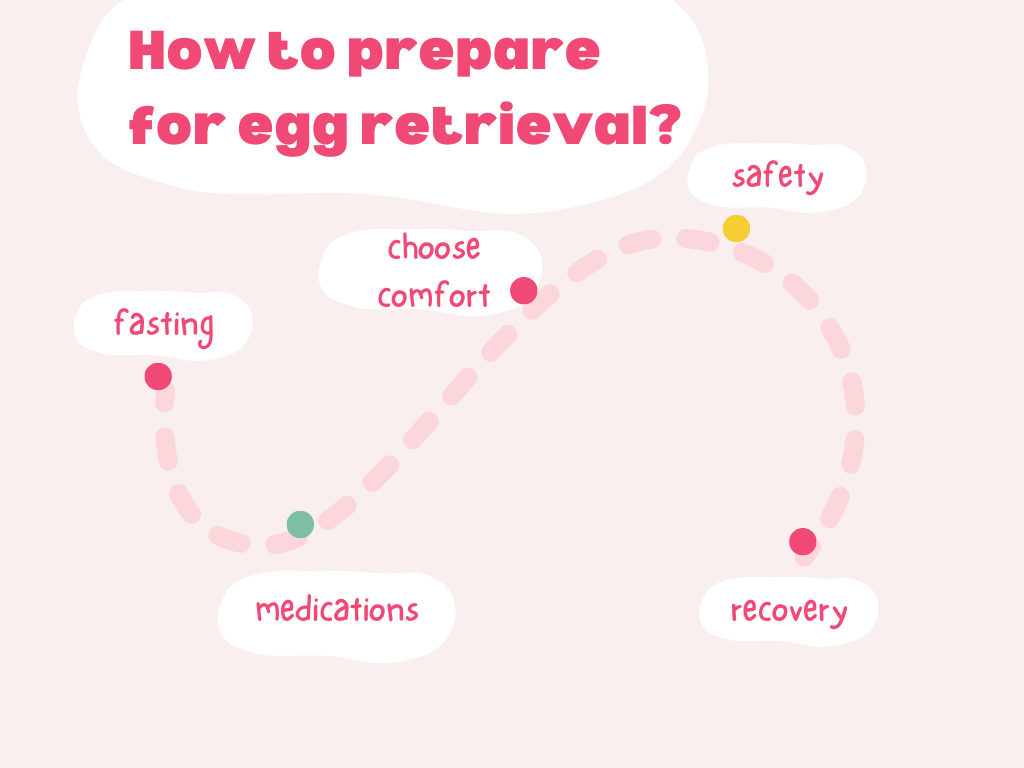What started out as an experiment in the field of IVF around 40 years ago is now the trump card of reproductive hoices for women today.
Egg freezing or oocyte cryopreservation allows women to freeze their eggs at a younger age, when they are of higher quality, for future use in in vitro fertilization (IVF) cycles.
If you’re considering egg freezing, came across it in an article or just want to know more about it, this article is your one stop solution.
I’m Navya, a former embryologist, diving deeper into what egg freezing is, who it’s for, how the procedure goes and what happens in the lab as well, during each step of the process.
So, grab that cup of coffee and read on!
Table of contents
- Who is egg freezing for?
- How does the egg freezing process start?
- How does egg freezing work?
- How is egg freezing done in the lab?
- How do I prepare for egg retrieval?
- How are my frozen eggs stored?
- How do I use my frozen eggs?
Who is egg freezing for?
Egg freezing is a viable option for various women in India, including:
- Women pursuing higher education or careers: Delaying childbearing due to educational goals or career aspirations is a common reason for choosing egg freezing. Freezing eggs at a younger age ensures a higher number of healthy eggs for potential future use.
- Women with medical conditions: Medical conditions or treatments that could compromise future fertility (e.g., cancer treatment) can prompt women to consider egg freezing as a way to preserve their reproductive potential.
- Women with a family history of early menopause: If you have a family history of early menopause, freezing your eggs earlier can provide options for future family planning.
- Women seeking single parenthood: Egg freezing allows women who desire single parenthood more control over their family-building timeline.
How does the egg-freezing process start?
Before starting with the egg-freezing process, some initial tests are recommended:
1. Hormonal evaluation
Blood tests assess hormone levels, such as Anti-Müllerian Hormone (AMH), estrogen and follicle-stimulating hormone (FSH) which provides insight into your ovarian reserve and the potential number of eggs you may retrieve.
2. Ultrasound scan
A pelvic ultrasound scan or a transvaginal ultrasound known as antral follicle count (AFC) evaluates the health of your ovaries and uterus, ensuring suitability for egg retrieval.
3. Infectious disease screening
Testing for infectious diseases like HIV, Hepatitis B, and Hepatitis C is a standard protocol to protect your health and the safety of future embryos.
How does egg freezing work?

Once the tests are done, and the green signal is given by the gynaecologist for the egg freezing procedure, you may be asked to visit the clinic during days 2 or 3 of your menstrual cycle. This is where the process starts:
1. Hormonal stimulation
After an initial evaluation via an antral follicle count scan, the stimulation starts. In some cases, such as PCOS where your periods are irregular or absent, you may be given birth control to regulate your menstrual cycle before starting with hormonal stimulation.
To stimulate egg production, you’ll undergo hormonal stimulation using injectable medications for approximately 10-12 days. These include injectable hormones and gonadotropins that help in recruiting more follicles and promote their growth.
Follicles are sac-like structures in the ovaries that house and grow the egg till maturation. They start from the baby stage (3-5mm) (that’s what doctors see on Day 2 or 3 of your menstrual cycle!) and grow in response to the medications in the egg-freezing cycle.
Compared to natural cycles where a group of follicles grow and one matures to release the egg of the month, during egg freezing, the medication helps recruit a group of follicles and aim to mature them all, to increase the number of mature eggs on the day of egg retrieval.
2. Ultrasound monitoring
Regular blood tests and ultrasound scans help monitor follicle growth and adjust medication dosages if needed.
With regular ultrasounds, the follicles are regularly monitored until they reach size of 16-22mm, which is when they are estimated to be mature.
3. Maturation trigger
Once follicles reach a certain size, a human chorionic gonadotropin (hCG) trigger shot is given to induce final egg maturation before retrieval.
This injection typically occurs 34-36 hours before the egg retrieval procedure. This is to ensure that the eggs are mature right around the time of egg retrieval.
4. Egg Retrieval
Finally, the egg retrieval process itself!
Egg retrieval is a minimally invasive procedure performed under anaesthesia.
Gynecologists use a transvaginal ultrasound that guides a thin needle through the vagina and to the ovaries. The needle then punctures the follicles to aspirate the follicular fluid containing the eggs.
5. Egg Preparation and freezing
The embryologist carefully identifies mature eggs in the follicular fluid and removes surrounding cumulus cells.
The eggs then undergo a vitrification process, a rapid freezing technique using liquid nitrogen. The eggs are stored in cryolocks, named as per patient identifiers, capped, dipped and stored in liquid nitrogen, to preserve them for future use.
How is Egg Freezing done in the laboratory?
The embryologist plays a crucial role in egg freezing:
The tubes of follicular fluid that contain the eggs are passed to the laboratory where they are kept in heated blocks.
This is to ensure that the temperature of the egg cell is maintained to our body’s temperature as the egg or oocyte is very sensitive to temperature changes.
The embryologist’s workstation is also heated to a temperature of 37 to 38°C. The embryologist takes a Petri dish from the warming incubator (pre-incubated right before the egg retrieval) and pours a tube of follicular fluid in it to identify the eggs.
- Egg Identification: The follicular fluid is examined under a microscope to identify eggs surrounded by a clear zona pellucida (protective outer layer) and cumulus cells. Sometimes embryologists may also spot empty follicles where the cumulous cells are there, but there is no egg.
- Once all the tubes are examined, all the eggs with the cumulus cells are placed in a single petri dish in a warming incubator.
- Incubation: The eggs are left in the incubator for around two hours. This is to ensure that the cytoplasm as well as the nucleus of the egg, mature. This is a crucial step for successful fertilization.
- Denudation: The final step involves removing the surrounding cumulus cells with specialized enzymes (hyaluronidase), allowing for visualization of the egg’s maturity through the presence of polar bodies. Only mature eggs (Metaphase II stage) are suitable for freezing due to their higher fertilization and implantation potential. Immature eggs (M I or GV stage) have lower survival rates after thawing and are not typically frozen.
How do I prepare for egg retrieval?

Here’s how to prepare for your egg retrieval:
- Fasting: You will be instructed to avoid food and drink for a specific period (usually the night before) the procedure due to anaesthesia requirements.
- Medications: Inform your doctor about any medications you’re taking, as some may need to be adjusted or discontinued before the procedure.
- Comfort and safety: Remove jewellery, wear loose-fitting clothing, and avoid applying lotions or fragrances near the procedure area.
- Recovery: Following the procedure, you’ll rest in the recovery room for a few hours before being discharged with recovery instructions. Expect mild cramping or discomfort, which you can let your healthcare provider know of so you can be prescribed pain medication.
How are my frozen eggs stored?
As the last step of vitrification, eggs are first placed in a cryolock device, along with some media. Around 2-3 eggs can be placed in a single cryolock storage device.
They are then transferred to storage tanks containing liquid nitrogen maintained at extremely low temperatures (-196°C). These tanks are continuously monitored and refilled with liquid nitrogen to ensure optimal storage conditions for your frozen eggs.
How do I use my frozen eggs?
When you’re ready to use your frozen eggs, you just have to notify the clinic.
You will then have to prepare yourself for an embryo transfer. The gynaecologist will craft a protocol for embryo transfer, and you will be on medications that prep your uterus for the same.
Using frozen eggs also means signing up for Intracytoplasmic sperm injection over in vitro fertilization as the outer layer of the egg cell hardens up, making it harder for IVF to occur.
The embryologist then thaws the oocyte and uses intracytoplasmic sperm injection (ICSI). During ICSI, a single healthy sperm is directly injected into each mature egg, mimicking the natural fertilization process.
The fertilized eggs (embryos) will then develop in a controlled laboratory environment for a few days.
The highest quality embryo(s) will be selected for transfer into your uterus through a procedure called embryo transfer.
Any remaining good-quality embryos can be cryopreserved for future cycles. There is also an option to donate them to other couples trying to conceive or for research purposes.
Egg freezing, in a nutshell
Egg freezing empowers women to take control of their fertility timeline.
By understanding the process, potential benefits, and considerations, you can make informed choices about whether it’s for you, or you want to think about it.
Regardless, consulting a qualified fertility specialist is crucial to discuss your individual situation and determine if egg freezing is the right option for you.
It’s time we have control over our reproductive choices and health❤️
